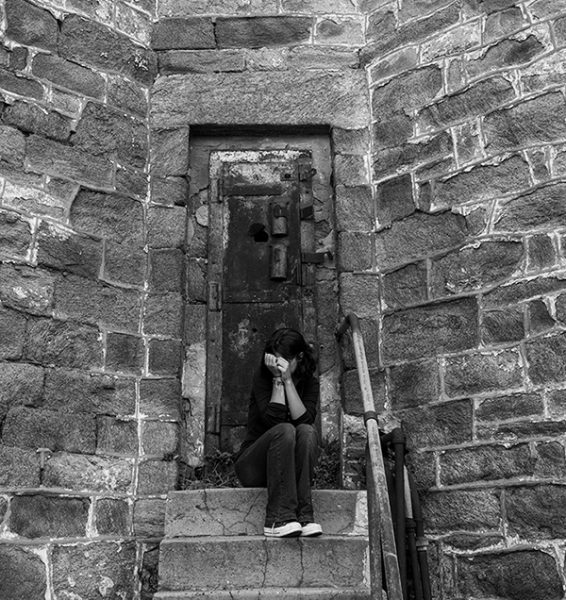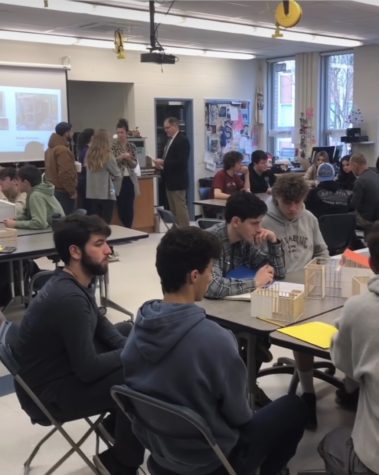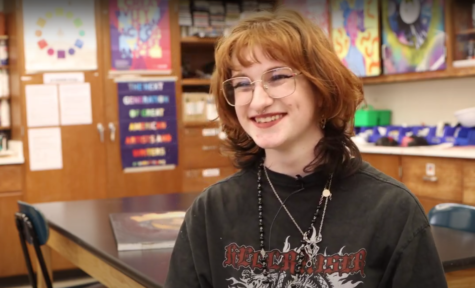Renegade Review: Bird Box
February 20, 2019
SPOILER WARNING
You’ve probably heard of, or attempted, the Bird Box challenge. For now, take off the blindfold, because there is more to this movie than memes.
The movie alternates between flashbacks and present day, a move that adds suspense and curiosity for the audience. It opens with the protagonist, Malorie, and two children trying to navigate rough waters.
Before any of the questions that arise are answered, there’s a flashback. Malorie and her sister, Jessica, are introduced. Malorie is pregnant, and the father is out of the picture. Malorie hasn’t left her apartment in months. News on their TV reveals that a rapid and mysterious suicide epidemic is spreading across the globe.
Rushing out of an ultrasound visit, the sisters encounter their community in hysterics.
Startled, Malorie is taken into a home for refuge. As Malorie makes some survival buddies, the audience learns there are monsters that, if looked at, are driving people to want to kill themselves.
After a treacherous odyssey, Malorie makes it to the safe haven, a school for the blind, with Girl and Boy intact. She finally gives these children names: Olympia and Tom, as a tribute to those she loved.
First, let’s discuss the monsters and their messengers. One theory is that the monsters represent the isolated tendencies of a technology-exposed society.
Malorie’s paintings show a cluster of people, all looking down, not at each other. There is a light illuminating some faces, suggesting they’re looking at a phone. The painting is dark and miserable, a consequence of society’s collective addiction to technology. There’s a disconnect between people, just as there’s a disconnect between Malorie and her kids, and the idea of being a mother. Individuals have trouble relating to and supporting others.
The monsters’ messengers, like the marketing in social and television media, want people to look at the monsters, or media, and become addicted to it.
Social and television media influence viewers to consume products through sponsorships and commercials. These advertisements with promises of consumer benefit (i.e. this product will let you say goodbye to your receding hairline!) are eerily similar to how the monster’s messengers pressures everyone to look at the “beautiful” monsters.
The messengers are particularly interested in getting children to look, like when Gary tried to get infant Girl and Boy to look at him in the bedroom. This is similar to how technology and television or social media are being marketed to children, because they’re impressionable and willing to engage in technology. If this movie is trying to implicitly illustrate the dangers of any brainwashing and time consuming media and the consequentially isolated environment, why has this become a popular internet joke? Young individuals are making memes of a movie explaining to them that memes are taking over and ruining connectivity to people. Hm.
The other theory on the monsters is that they represent internal “monsters.”
Each character sees a different creature, just as each individual in society interprets and reacts to topics differently. Society may force emotionally unstable or sensitive people into isolation, leading to emotional repression and other forms of self-harm, even suicide.
Another theory is that the messengers represent those who have experienced abject internal agony, to the point that nothing else can hurt them, because they’ve accepted their pain. These hurt individuals love their monsters and want to encourage others to see them because they are physical forms of their mental distress, which can be reassuring for people with mental illness. They embrace their monsters because pain in physical form is more easily understood. The audience does not see the monsters, however, because everyone is as blind as the characters when it comes to seeing other’s internal suffering.
Throughout the entire movie, Malorie is distant from other characters. She’s a bird stuck in a box.
When Malorie, Girl, and Boy make it safely into the school for the blind, birds fly around freely and everyone is safe and peaceful. This is where Malorie frees the birds from the box and gives the children their names, the ultimate metaphor for freedom and connectivity.
Bird Box isn’t just a jokeable movie, but an interesting story with many conceptual layers. A takeaway could be to put down the phone and connect with others, because everyone has their own “monsters.” Another takeaway could be that it wasn’t scary. However, some movies require a deeper understanding for it to truly be an incredible psychological thriller. Next time consider watching without anticipation of jumpscares or freaky monsters, but the underlying messages and the way the plot stimulates your senses.







